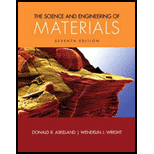
What are the primary types of atomic bonds in ceramics?
To discuss: The type of bonds in ceramics.
Explanation of Solution
A ceramics is a type of solid material that contains metals, non-metals, inorganic material, and metalloid atoms. The properties of ceramics material are hard, brittle, and resistant to heat and corrosion. Ceramics material is used for domestic as well as industrial applications. Also, they are used in arts. The example of ceramics is brick, porcelains, earthenware, etc.
The particles of ceramics are closely packed and strongly attached. So, in ceramics, the electronegativity properties of atoms give ionic and covalent bonds.
Ionic bonding:
In ionic bonding, the valance electrons transfer between atoms which generate positive and negative chemical ions.
In the approach of bonding, there is a loss of metal in electron, and metal becomes positively charged ions, while non-metals accept the electron and become a negatively charged ion.
Covalent bonding:
The covalent bonding in ceramics arises by sharing of electrons between atoms. When the elements have the same periodic table position or near to the table position, the bond between elements arises by sharing electrons between atoms. This is called covalent bonding.
Want to see more full solutions like this?
Chapter 15 Solutions
The Science and Engineering of Materials (MindTap Course List)
- Are ceramics (clay) considered a synthetic material? Why or why not? #EngineeringMaterials #MaterialsandScienceEngineeringarrow_forwardFor each of the following - choose the best response For Traditional Vs Advanced Ceramics Group of answer choices Coarser structure Less expensive Made from natural raw materials Higher strength Higher fracture toughnessarrow_forwardWhat are the key advantages and applications of ceramic materials in the field of mechanical engineering?arrow_forward
- Create your own tree diagram of ceramics materials classification based on application, then briefly discuss the diagram you created in five sentencesarrow_forwardWhat are the importance of Ceramics in Engineering? Give some examplesarrow_forwardWhat are the differences between mud casting, hollow casting and full casting in ceramics?arrow_forward
- The maximum principal strain failure criterion is appropriate for ceramic materials". Is this true or false?arrow_forwardWrite or introduce the following topics of ceramics: • Types of ceramics • Sintering • Metal processing • Bioactive glassarrow_forwardWhich is the correct property of ceramics?arrow_forward
- Why some automotive components are made of ceramics? Give as many reasons as possible.arrow_forwardCompare metals, polymers and ceramics on a chart or Table using the following properties and the ratings, low, high and highest:DensityDuctilityHardnessCorrosion resistanceHardnessThermal conductivityElectrical conductivityWear resistance.arrow_forwardWhat are ceramics? List and briefly explain five important properties of ceramics that make them useful engineering materials.arrow_forward
 Elements Of ElectromagneticsMechanical EngineeringISBN:9780190698614Author:Sadiku, Matthew N. O.Publisher:Oxford University Press
Elements Of ElectromagneticsMechanical EngineeringISBN:9780190698614Author:Sadiku, Matthew N. O.Publisher:Oxford University Press Mechanics of Materials (10th Edition)Mechanical EngineeringISBN:9780134319650Author:Russell C. HibbelerPublisher:PEARSON
Mechanics of Materials (10th Edition)Mechanical EngineeringISBN:9780134319650Author:Russell C. HibbelerPublisher:PEARSON Thermodynamics: An Engineering ApproachMechanical EngineeringISBN:9781259822674Author:Yunus A. Cengel Dr., Michael A. BolesPublisher:McGraw-Hill Education
Thermodynamics: An Engineering ApproachMechanical EngineeringISBN:9781259822674Author:Yunus A. Cengel Dr., Michael A. BolesPublisher:McGraw-Hill Education Control Systems EngineeringMechanical EngineeringISBN:9781118170519Author:Norman S. NisePublisher:WILEY
Control Systems EngineeringMechanical EngineeringISBN:9781118170519Author:Norman S. NisePublisher:WILEY Mechanics of Materials (MindTap Course List)Mechanical EngineeringISBN:9781337093347Author:Barry J. Goodno, James M. GerePublisher:Cengage Learning
Mechanics of Materials (MindTap Course List)Mechanical EngineeringISBN:9781337093347Author:Barry J. Goodno, James M. GerePublisher:Cengage Learning Engineering Mechanics: StaticsMechanical EngineeringISBN:9781118807330Author:James L. Meriam, L. G. Kraige, J. N. BoltonPublisher:WILEY
Engineering Mechanics: StaticsMechanical EngineeringISBN:9781118807330Author:James L. Meriam, L. G. Kraige, J. N. BoltonPublisher:WILEY





